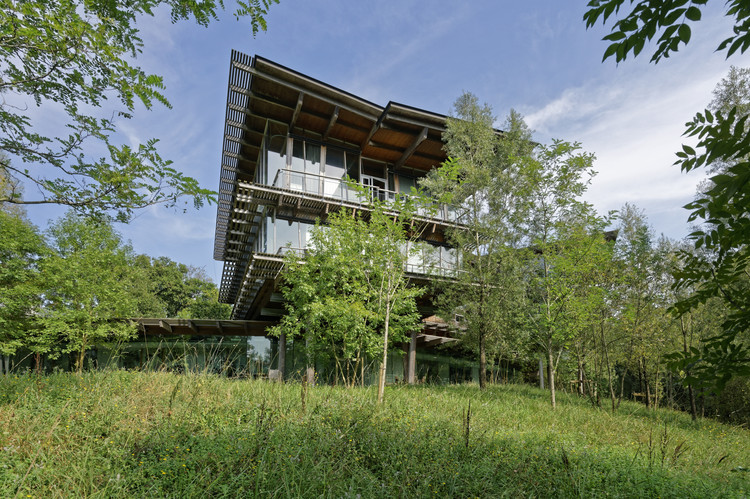Hirozakari Sake Brewery Kunihiko Matsuba + Ksuke Fukushima
2011-07-21 00:00
架构师提供的文本描述。我们的计划是重建野马县Nakanojo-machi拥有的原名Hirozakari清酒酿酒厂,作为一个活动设施(今年的第一段)。作为石马温泉的所有者,Nakanojo-machi最近一直积极参与推动文化和艺术活动,包括Nakanojo Biennale。以前的裕崎酒酿酒厂曾被用作这些活动的中心。为这项计划,我们创造了建筑设施的设计,以储存和展示11个被冈马县指定为重要的有形民间文化财产的猎鸟鼓,以及改造现有仓库和厕所的设计。
Text description provided by the architects. Our plan is to reconstruct the former Hirozakari Sake Brewery site owned by Nakanojo-machi, Gunma Prefecture, as an event facility (first period of this year). As the owner of Shima springs, Nakanojo-machi has recently been taking an active part in promoting cultural and art events, including the Nakanojo Biennale. The former Hirozakari Sake Brewery site has been used as the center for these events. For this plan, we created designs for the construction of facilities to store and exhibit eleven bird-hunting drums, which are designated by Gunma Prefecture as important tangible folk cultural properties, along with designs for the renovation of the existing warehouse and washroom.
为了将以前的清酒酿酒厂场地作为一个活动设施,Nakanojo-Machi于2007年购买了该啤酒厂的土地和建筑物。不过,由于现时的楼宇已非常破旧,所以很难全部使用原来的建筑物。因此,我们决定拆除这些建筑物,除办公楼(钢结构)、储藏室(石头结构)和仓库(木结构)外,这些建筑维护良好,建筑空间也具有吸引力。拆除后,我们在以前的啤酒厂场地建立了一个公共空间,包括一个储藏/展览室和一个花园。我们还计划积极利用建筑物之间的空间,这些空间是通过拆除和建造的顺序创造的,我们利用这些空间进入建筑物和露天展览空间。
In order to use the former sake brewery site as an event facility, Nakanojo-machi purchased the land and buildings of the brewery in 2007. However, as the existing buildings were very dilapidated, it was difficult to use all the buildings in their original state. So, we decided to demolish these buildings, except for the office building (steel structure), the storage room (stone structure) and the warehouse (wooden structure), which are well maintained and also have attractive features as architectural spaces. After the demolition, we created a public space, including a storage/exhibition room and a garden, at the former brewery site. We also planned to make positive use of the spaces between buildings that were created through the sequences of demolition and construction, and we used those spaces for approaches to the buildings and open-air exhibition spaces.
建筑方法的目的是创造一个完全不同的世界内的气氛,在以前的清酒酿酒厂,直到现在,是不符合我们的设计政策。然而,与此同时,仅仅利用现有建筑的气氛来创造整齐有序的结构的方法却完全没有吸引力。因此,我们决定根据个别楼宇的用途及位置,采用不同的设计方法,以配合一套宽松的设计政策,即轻微扭曲现时的空间。
Architectural methods aimed at creating an entirely different world from the atmosphere within the former sake brewery until now were inconsistent with our design policy. At the same time, however, methods that only used the atmosphere of the existing buildings to create neatly organized structures felt completely uninteresting. So, we decided to apply various methods depending on the use and location of individual buildings, in accordance with a loosely formulated design policy of slightly distorting the current space.
根据其性质,新建的仓库/展览室的外墙上除了运输桶所需的孔外,没有任何开口。我们没有创造洞口,而是建造了一条隧道式通道,贯穿整个建筑,这样游客就可以体验室内空间。这条通道两边都有双强度玻璃板(最大高度:4.5米),由上、下两层框架支撑。由这些面板形成的两个玻璃屏幕不是完全平行的,而是稍微倾斜的,因此它们似乎扩展到广场和水道外面。由于这种设计,这些玻璃屏幕反复相互反射,在通道内创建的多层图像具有很强的视觉冲击力。被铝锌合金钢板覆盖的建筑外观让我们想起了木板墙。尽管它的现代风格,没有屋檐或山墙,这座建筑创造了一种传统的日本氛围,与旧仓库和其他现有建筑相匹配。
By its nature, the newly constructed storage/exhibition room does not have any openings on its exterior walls other than those required for the transportation of drums. Instead of creating openings, we built a tunnel-like passage that runs through the building so that visitors can experience the interior space. This passage is lined on both sides with double-strength glass panels (maximum height: 4.5 m) that are supported by upper and lower frames. The two glass screens formed by these panels are not perfectly parallel with each other but are slightly tilted so that they appear to expand into the square and the watercourse outside. Due to this design, these glass screens repeatedly reflect each other, and the multi-layered images created inside the passage have a strong visual impact. The exterior appearance of the building covered with aluminum-zinc alloy-coated steel plates reminds us of boarded walls. Despite its modern style with no eaves or gables, the building creates a traditional Japanese atmosphere that matches the old warehouse, and other existing buildings.
我们把旧仓库整修成展览室。然而,与普通展厅不同的是,该房间的混凝土地板略有倾斜(1.8度)。这间展览室被剥夺了一层楼,这在我们的世界被认为是理所当然的,它的设计是为了激发艺术家以创造性的方式创作和展示艺术作品。我们希望,这个房间将服务于那些以远远超出我们想象的方式使用它的艺术家的目的。
We renovated the old warehouse into an exhibition room. However, unlike ordinary exhibition rooms, the concrete floor of the room is slightly tilted (1.8o). Deprived of a level floor, which is taken for granted in our world, the exhibition room is designed to inspire artists to produce and exhibit art works in creative ways. We hope that the room will serve the purposes of those artists that use it in ways far beyond our imagination.
洗手间位于旧烟幕的底部,配备了不锈钢镜面,宽6米,高2米。坐在马桶上的游客会看到自己的身体在镜子中反射出来。镜面的上半部弯曲,曲率r=5米;因此,镜子呈现出游客上半身的扭曲图像。由于艺术家已计划在旧烟幕底部画,我们希望他们能利用镜子的性质,创造一个洗手间,让游客感到惊喜和愉悦。
The washroom, which is located at the bottom of an old smoke stack, is equipped with a stainless steel mirror panel that measures 6 m in width by 2 m in height. A visitor sitting on the toilet will see his or her own body reflected in the mirror. The upper half of the mirror panel is bent with a curvature of r = 5 m; consequently, the mirror presents a distorted image of the visitor’s upper torso. Since it is already planned for artists to draw paintings at the bottom of the old smoke stack, we hope they will be able to use the nature of the mirror panel so as to create a washroom that provides surprise and pleasure to visitors.
外面的区域被尽可能多的草坪覆盖着。然而,我们也非常小心地为鼓的运输扫清了道路,促进了健康的草的生长。用草坪覆盖地面不仅有助于创造一个宜人的环境,而且还能防止地面的热辐射,并将仓库周围的温度升高降到最低。50个免维护的LED灯嵌在沿着水道的地面上.当太阳下山时,这些灯开始闪烁,在苍白的颜色,创造了一个美丽的夜景。
The outside area is covered with as much lawn as much as possible. However, we also took great care to clear the way for the transportation of drums and to promote the growth of healthy grass. Covering the ground with lawn not only helps create a pleasant environment, but also prevents heat radiation from the ground and minimizes temperature increases around the warehouse. Fifty maintenance-free LED lights are embedded in the ground along the watercourse. When the sun sets, these lights starts to blink on and off in pale colors, creating a beautiful nightscape.
在第二阶段及以后的计划中,我们将继续对每栋建筑采用不同的改造方法,这是基于我们对空间略有扭曲的无限小接近零的政策。总的来说,我们希望一开始创造出一个看似脱节的东西,但经过更仔细的观察,我们发现它就像一个杂乱无章的东西,由独立的部分组成,按照一贯的政策,这些独立的部分被整合成一个有组织的整体。
In plans for the second period and later, we will continue renovation by using different methods for each building, based on our infinitesimally-close-to-zero policy of slightly distorting the space. Overall, we hope to create something that looks disconnected at first, but upon closer inspection turns out to be like a patchwork, composed of independent pieces that are integrated into an organized whole in accordance with a consistent policy.
 举报
举报
别默默的看了,快登录帮我评论一下吧!:)
注册
登录
更多评论
相关文章
-

描边风设计中,最容易犯的8种问题分析
2018年走过了四分之一,LOGO设计趋势也清晰了LOGO设计
-

描边风设计中,最容易犯的8种问题分析
2018年走过了四分之一,LOGO设计趋势也清晰了LOGO设计
-

描边风设计中,最容易犯的8种问题分析
2018年走过了四分之一,LOGO设计趋势也清晰了LOGO设计































































.jpg)








